Speak Like a Doctor: How Medical Words Work
The mastery of medical terminology is not just an academic exercise; it is a crucial tool for effective communication within the healthcare sector. Understanding these terms enhances clarity and precision in patient care, research, and collaboration among healthcare professionals.
This article aims to empower the public or medical professionals with a thorough grasp of medical terminology. It is designed to build a strong foundation in the basic structure and usage of medical terms, delving into the intricacies of their origins, applications, and evolving nature. With this knowledge, future healthcare providers can navigate the complex world of medicine with confidence and competence.

Foundations of Medical Terminology
The Structure of Medical Words
The basic structure of medical words includes root words, prefixes, and suffixes. Root words provide the core meaning, prefixes modify this meaning, and suffixes often indicate the word’s type or the body part involved. Understanding this structure is key to deciphering medical language.
Table 1: Common Greek and Latin Roots, Prefixes, and Suffixes
|
Component |
Example |
Meaning |
Type |
|---|---|---|---|
|
Root |
Cardi |
Heart |
Greek |
|
Prefix |
Hyper- |
Over, Excessive |
Greek |
|
Suffix |
-itis |
Inflammation |
Latin |
|
Root |
Gastr |
Stomach |
Greek |
|
Prefix |
Sub- |
Under, Below |
Latin |
|
Suffix |
-ectomy |
Removal |
Greek |
|
Root |
Hemat |
Blood |
Greek |
|
Prefix |
Anti- |
Against |
Greek |
|
Suffix |
-oma |
Tumor |
Greek |
Combining forms, where a vowel is used to connect roots and improve pronunciation, are also essential. For example, ‘oste/o’ (bone) can be combined with ‘arthr’ (joint) to form ‘osteoarthritis’.
Visual 2: Diagram of Medical Term Construction
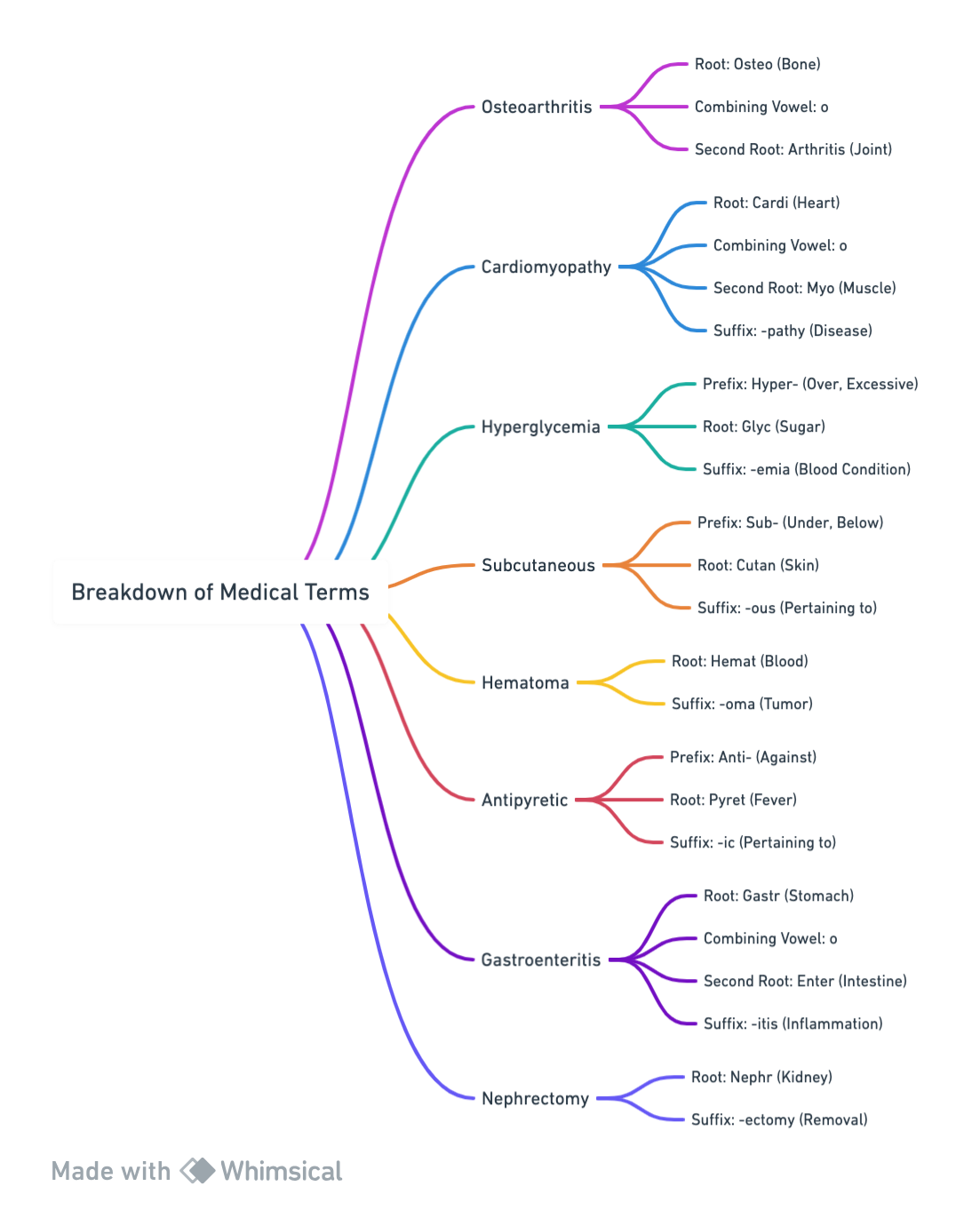
The Origin of Medical Terms
Medical terms often originate from Greek and Latin. Knowledge of these languages’ influences helps in understanding and memorizing complex terms.
Table 2: Examples of Terms Derived from Greek and Latin
|
Term |
Origin Language |
Original Words |
Meaning |
|---|---|---|---|
|
Cardiology |
Greek |
Cardia + Logos |
Study of Heart |
|
Pulmonary |
Latin |
Pulmo |
Pertaining to Lung |
|
Hematology |
Greek |
Haima + Logos |
Study of Blood |
Historical context enriches the understanding of medical terms. As medical science evolved, so did its terminology, adapting to new concepts and technologies.
Infographic 1: Evolution of Medical Terminology Timeline
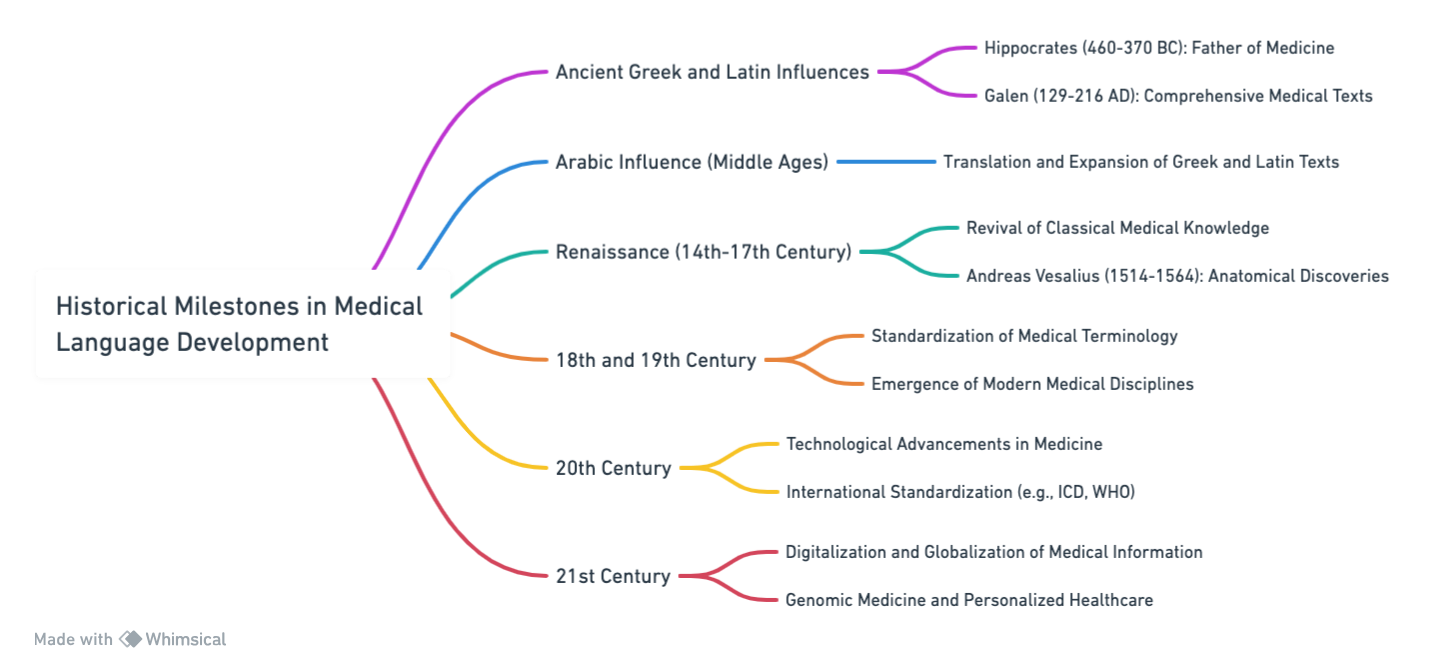
Understanding Medical Terms through Structure
Anatomical Terms
Anatomical terms often follow the structure of root, prefix, and suffix. This section will explore how these components build terms that precisely describe body parts and locations, enhancing comprehension and communication in medical settings.
Table 3: ‘Anatomical Terms and Their Structure’
|
Anatomical Term |
Root Word |
Prefix/Suffix |
Description |
|---|---|---|---|
|
Cephalic |
Cephal |
-ic (pertaining to) |
Relating to the head |
|
Brachial |
Brachi |
-al (pertaining to) |
Relating to the arm |
|
Thoracic |
Thorac |
-ic (pertaining to) |
Pertaining to the chest |
Visual 3: Annotated Human Body Diagram

Diagnostic Terms
Diagnostic terms, while not always following the root-prefix-suffix structure, are essential in identifying medical conditions. This subsection demonstrates their usage in the medical diagnosis process.
Table 4: ‘Common Diagnostic Terms and Their Structure’
|
Diagnostic Term |
Root Word |
Prefix/Suffix |
Description |
|---|---|---|---|
|
Biopsy |
Bio |
-opsy (viewing) |
Tissue examination |
|
MRI |
Magnetic Resonance |
Imaging |
Advanced imaging technique |
Visual 4: Flowchart of the Diagnostic Process
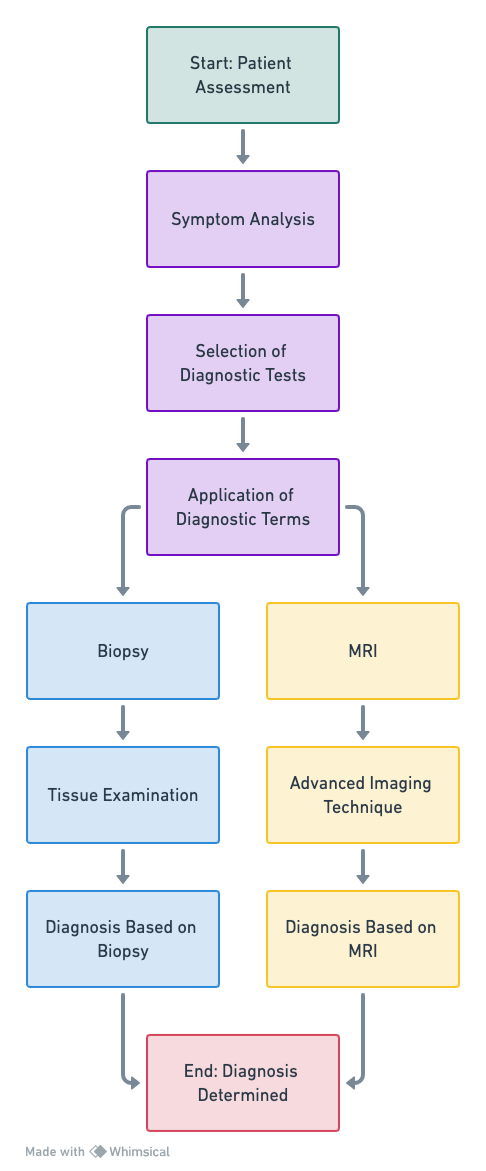
Symptomatic Terms
Terms describing symptoms often reflect their Greek or Latin roots. This subsection examines how understanding these roots aids in identifying and communicating patient symptoms.
Table 5: ‘Symptomatic Terms and Their Roots’
|
Symptom |
Root Word |
Description |
|---|---|---|
|
Dyspnea |
Dys- (difficult) + pnea (breathing) |
Difficulty breathing |
|
Tachycardia |
Tachy- (fast) + cardia (heart) |
Rapid heart rate |
Visual 5: Symptom-Diagnosis Mapping Diagram
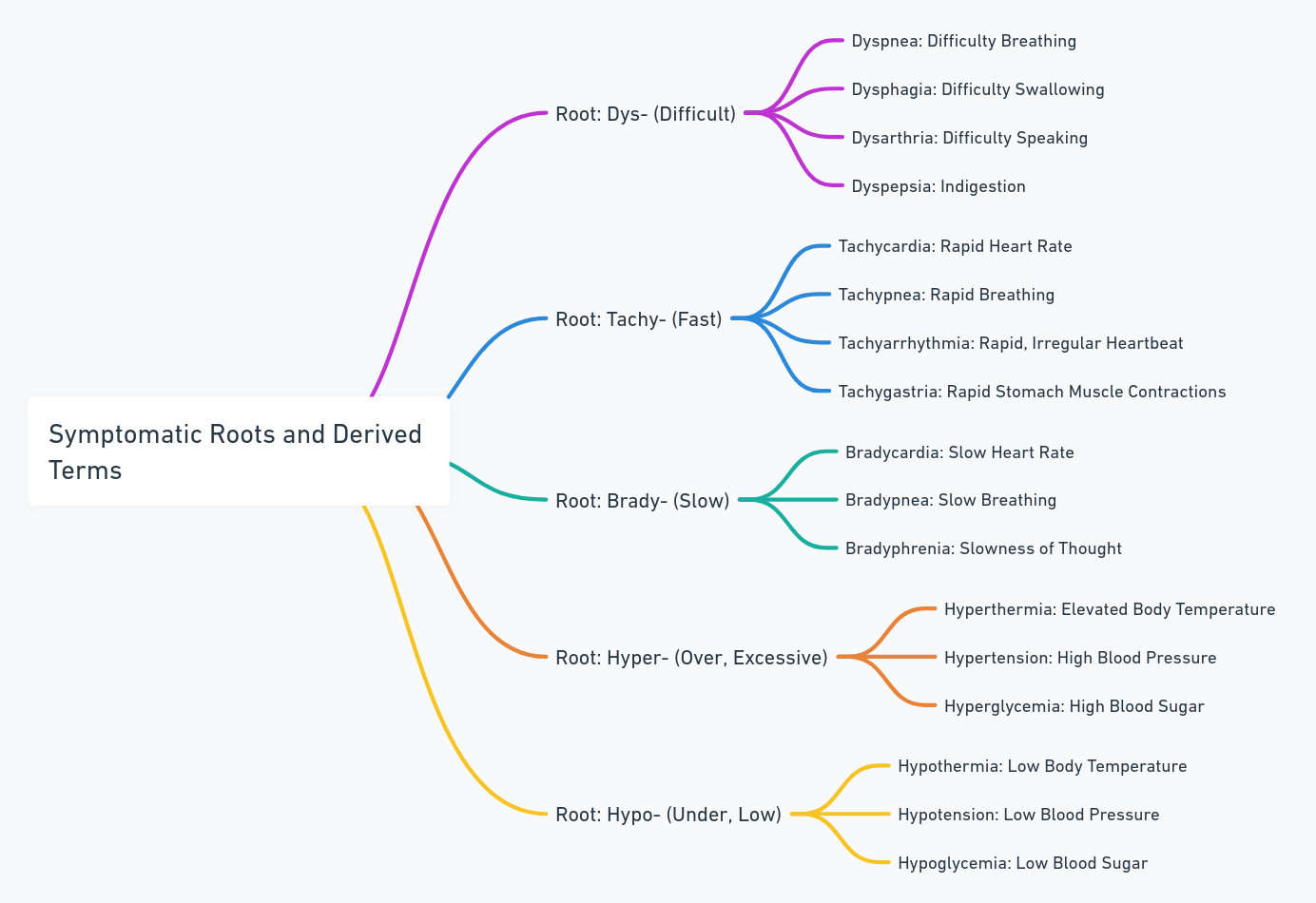
Surgical Terms
Surgical terms often combine Greek and Latin roots with specific prefixes and suffixes to describe procedures. This subsection reveals the structure behind common surgical terminologies.
Table 6: ‘Surgical Terms and Their Structures’
|
Procedure |
Components |
Description |
|---|---|---|
|
Cholecystectomy |
Chole- (bile) + cyst (sac) + -ectomy (removal) |
Gallbladder removal |
|
Arthroplasty |
Arthro- (joint) + -plasty (molding) |
Joint reconstruction |
Visual 6: Diagrams of Surgical Procedures
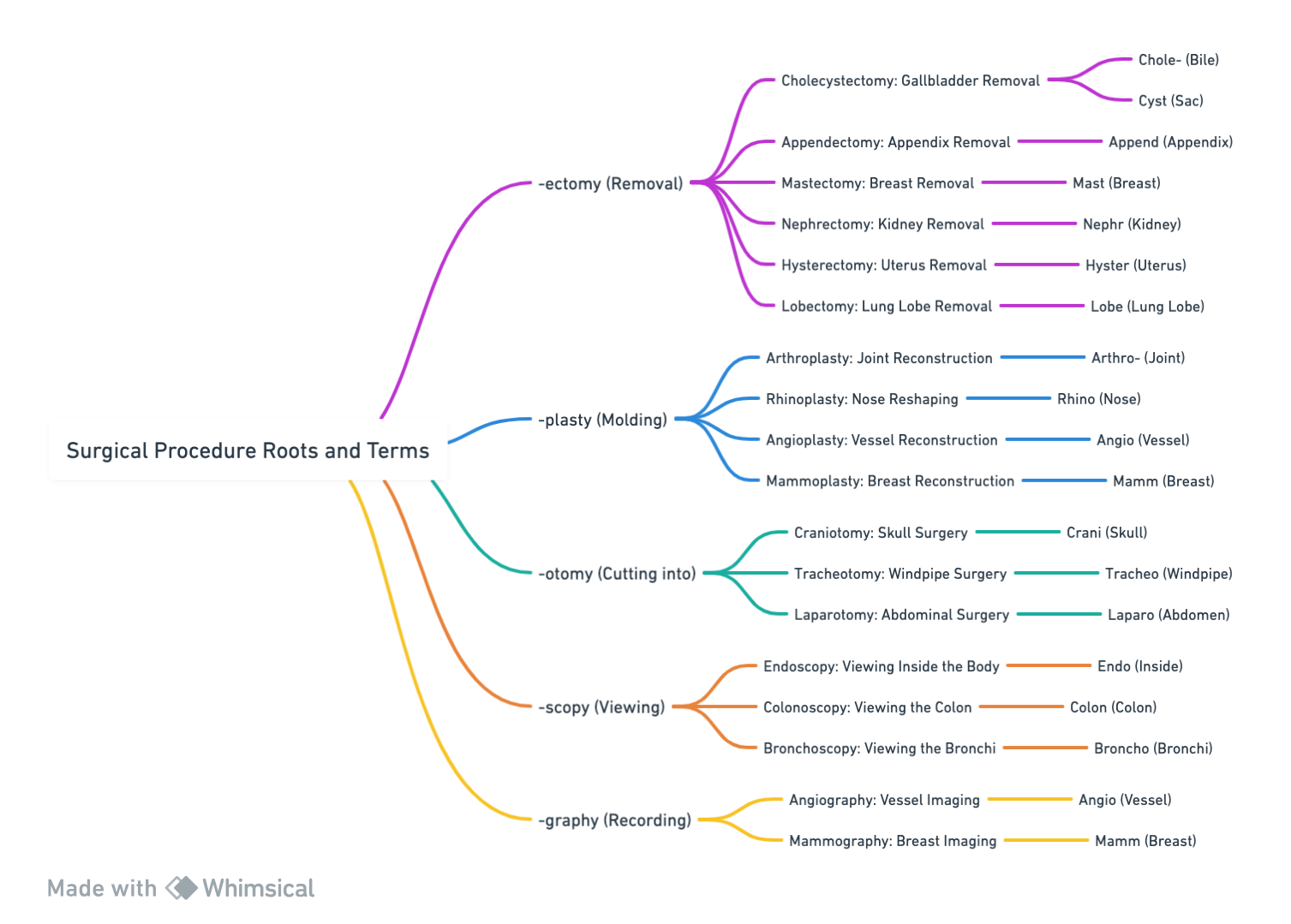
Pharmacological Terms
Pharmacological terms combine roots, prefixes, and suffixes to describe drug classes and their effects. This section delves into how these terms are structured and applied.
Table 7: ‘Pharmacological Terms and Their Structure’
|
Drug Class |
Components |
Description |
|---|---|---|
|
Analgesics |
An- (without) + algesia (pain) |
Pain relievers |
|
Antibiotics |
Anti- (against) + biotic (life) |
Bacteria-fighting drugs |
Pathological Terms
Pathological terms often derive from Latin and Greek, helping describe diseases and conditions. This subsection explores the structure behind these terms.
Table 8: ‘Pathological Terms and Their Roots’
|
Disease/Disorder |
Components |
Description |
|---|---|---|
|
Osteoarthritis |
Osteo- (bone) + arthritis (joint inflammation) |
Joint disease |
|
Leukemia |
Leuk- (white) + -emia (blood condition) |
Blood cancer |
Visual 7: Disease terminology
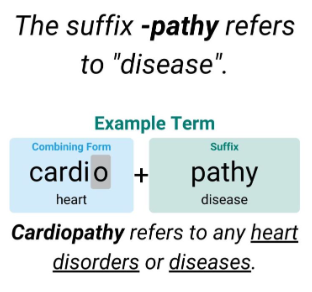
Building and Interpreting Medical Words
Decoding Medical Terminology
Decoding medical terminology requires understanding its foundational structure. Strategies for this include breaking down complex terms into their roots, prefixes, and suffixes, and learning the meaning of these components. Another effective method is to familiarize oneself with common medical terms in everyday practice. This not only aids in memorization but also helps in applying these terms in real-life medical contexts.
Interactive Table 1: ‘Mix-and-Match Roots, Prefixes, and Suffixes’
Mix-and-Match Roots, Prefixes, and Suffixes
Select a prefix, root, and suffix to create a medical term.
| Prefix | Root | Suffix |
|---|---|---|
| hyper- | therm | -ia |
| hypo- | gastr | -ic |
| intra- | derm | -itis |
| sub- | cardi | -osis |
| brady- | nephr | -ectomy |
| tachy- | neur | -plasty |
| angio- | oste | -gram |
| osteo- | my | -logy |
| myo- | hepat | -scope |
| hemi- | cephal | -megaly |
| hepato- | cyst | -centesis |
| arthro- | laryng | -itis |
| bio- | card | -pathy |
Combined Term: None
This table table allows learners can combine different roots, prefixes, and suffixes to form and understand various medical terms, and even make up ones that don’t exist.
Visual 9: Step-by-Step Guide on Decoding a Term 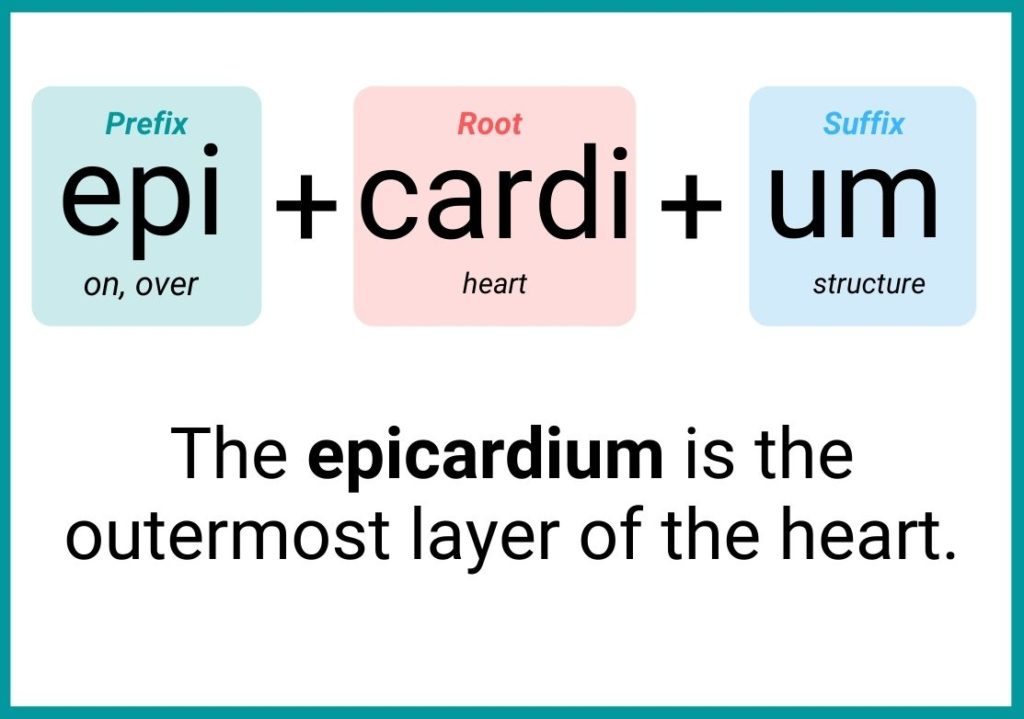
Practical Exercises
Practical exercises are invaluable for reinforcing the understanding and application of medical terminology. These exercises simulate real-world scenarios, challenging learners to apply their knowledge in interpreting and using medical terms correctly.
Exercise Set 1: Case Studies for Term Interpretation
Objective: The primary goal of this exercise set is to enhance students’ ability to interpret and apply medical terminology in real-world clinical scenarios. By analyzing these case studies, students will gain a deeper understanding of how medical terms are used in practice and the importance of accurate interpretation in patient care.
Case Study 1: Cardiovascular Concerns
- Scenario: A 65-year-old male patient presents with chest pain and shortness of breath. The ECG report shows signs of myocardial infarction.
- Task: Interpret the medical terms in the patient’s diagnosis and explain the implications for treatment and care.
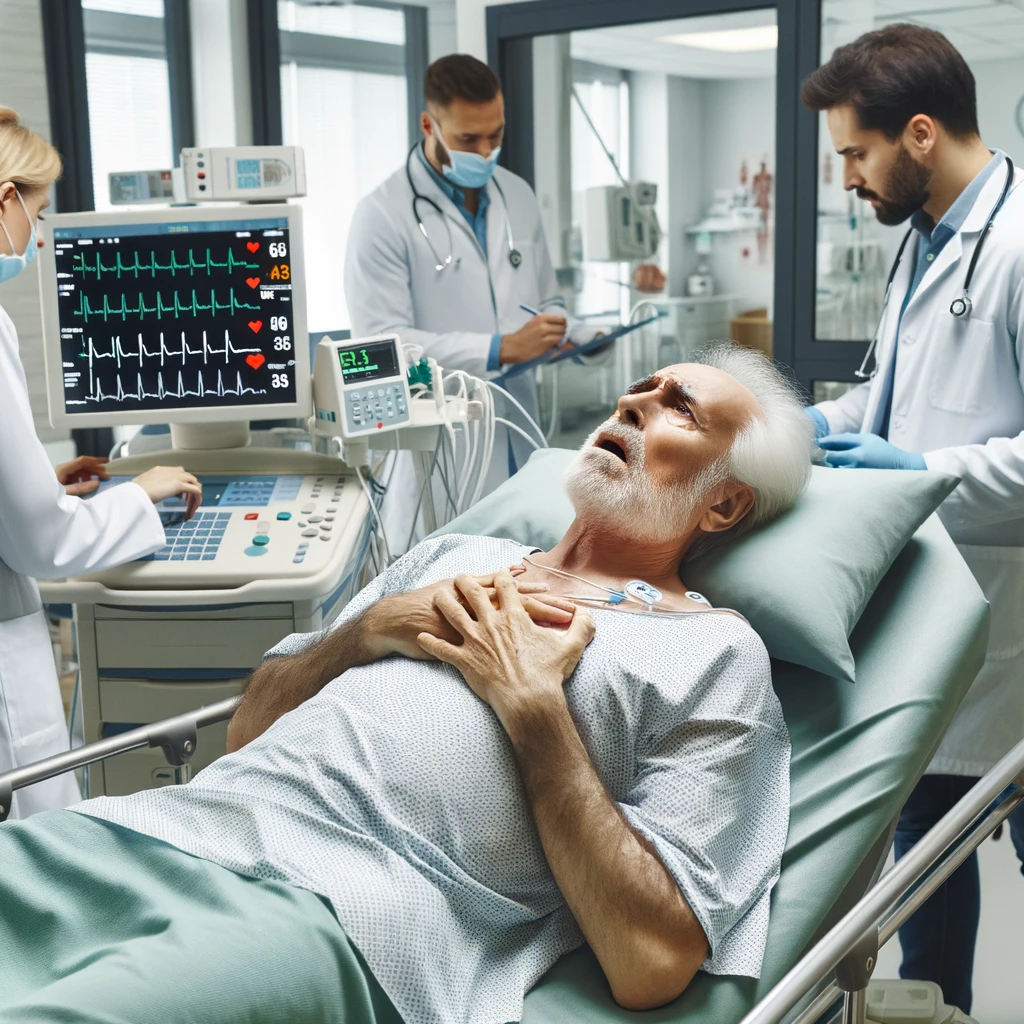
Case Study 2: Neurological Complications
- Scenario: A 30-year-old female exhibits symptoms of aphasia and hemiparesis after a stroke.
- Task: Define the terms aphasia and hemiparesis, and discuss the potential rehabilitation approaches.

Case Study 3: Pediatric Allergies
- Scenario: A 6-year-old patient is diagnosed with urticaria and angioedema, triggered by a food allergy.
- Task: Explain the terms urticaria and angioedema in the context of allergic reactions and outline the emergency treatment protocol.

Case Study 4: Gastrointestinal Disorders
- Scenario: A patient is diagnosed with gastroesophageal reflux disease (GERD) and peptic ulcer disease (PUD).
- Task: Describe the pathophysiology of GERD and PUD, and compare the treatment strategies for both conditions.

Case Study 5: Endocrine System Management
- Scenario: A patient with a history of diabetes mellitus presents with symptoms of polyuria, polydipsia, and polyphagia.
- Task: Interpret these symptoms in the context of diabetes management and discuss the necessary modifications in treatment.

Supporting Material:
- Glossary of Terms: A comprehensive list of the medical terms used in the case studies.
- Explanation Guides: Detailed descriptions of the conditions and symptoms for each case study.
- Treatment Overview: A brief overview of common treatments and management strategies for the conditions presented in the case studies.
Exercise Set 1: Case Studies for Term Interpretation – Answer Key
Case Study 1: Cardiovascular Concerns – Myocardial Infarction
- Myocardial
- Prefix: “Myo-” meaning muscle
- Root: “Cardi-” meaning heart
- Suffix: None
- Infarction
- Prefix: None
- Root: “Infarct-” meaning tissue death
- Suffix: “-ion” indicating a process
- Diagnosis Implication: The term indicates muscle death in the heart due to blocked blood supply.
Case Study 2: Neurological Complications – Aphasia and Hemiparesis
- Aphasia
- Prefix: “A-” meaning without
- Root: “Phas-” meaning speech
- Suffix: “-ia” indicating a condition
- Hemiparesis
- Prefix: “Hemi-” meaning half
- Root: “Pares-” meaning weakness
- Suffix: “-is” indicating a state
- Diagnosis Implication: Loss of speech and weakness on one side of the body.
Case Study 3: Pediatric Allergies – Urticaria and Angioedema
- Urticaria
- Prefix: None
- Root: “Urtic-” derived from Latin for nettle (referring to rash)
- Suffix: “-aria” indicating a condition
- Angioedema
- Prefix: “Angio-” meaning vessel
- Root: “Edem-” meaning swelling
- Suffix: “-a” indicating a condition
- Diagnosis Implication: Skin rash (hives) and swelling beneath the skin due to allergic reaction.
Case Study 4: Gastrointestinal Disorders – GERD and PUD
- Gastroesophageal Reflux Disease (GERD)
- Prefix: “Gastro-” meaning stomach
- Root: “Esophageal” referring to the esophagus
- Suffix: “-al” indicating related to; “Disease” is a standalone term
- Peptic Ulcer Disease (PUD)
- Prefix: “Pept-” meaning digestion
- Root: “Ulcer” meaning sore
- Suffix: None; “Disease” is a standalone term
- Diagnosis Implication: Acid reflux into the esophagus and digestive ulcers.
Case Study 5: Endocrine System Management – Polyuria, Polydipsia, Polyphagia
- Polyuria
- Prefix: “Poly-” meaning many
- Root: “Uri-” meaning urine
- Suffix: “-a” indicating a condition
- Polydipsia
- Prefix: “Poly-” meaning many
- Root: “Dips-” meaning thirst
- Suffix: “-ia” indicating a condition
- Polyphagia
- Prefix: “Poly-” meaning many
- Root: “Phag-” meaning eating
- Suffix: “-ia” indicating a condition
- Diagnosis Implication: Excessive urination, thirst, and hunger, common in uncontrolled diabetes.
Common Mistakes and Challenges
Common errors in medical terminology often arise from misinterpreting the roots, prefixes, and suffixes, leading to incorrect term formation or usage. Another frequent mistake is confusing terms with similar spellings or sounds but different meanings. Understanding and avoiding these errors is crucial for clear and accurate medical communication.
Table 11: ‘Common Errors in Medical Terminology and Corrections’
|
Error Example |
Correction |
Explanation |
|---|---|---|
|
Hyper- vs. Hypo- |
Hyperthyroidism (Excessive thyroid activity) vs. Hypothyroidism (Insufficient thyroid activity) |
Confusing ‘hyper-‘ (over) with ‘hypo-‘ (under) |
|
Itis vs. Osis |
Bronchitis (Inflammation of the bronchi) vs. Bronchosis (Abnormal condition of the bronchi) |
‘Itis’ indicates inflammation, while ‘osis’ refers to a general condition |
|
Ectomy vs. Otomy |
Appendectomy (Removal of the appendix) vs. Colotomy (Incision into the colon) |
‘Ectomy’ means removal, while ‘otomy’ indicates cutting into |
|
Ology vs. Opathy |
Cardiology (Study of the heart) vs. Cardiopathy (Disease of the heart) |
‘Ology’ denotes the study of, whereas ‘opathy’ refers to a disease |
|
Arterio- vs. Athero- |
Arteriosclerosis (Hardening of the arteries) vs. Atherosclerosis (Plaque buildup in arteries) |
Confusing ‘arterio-‘ (related to arteries) with ‘athero-‘ (plaque) |
|
Tachy- vs. Brady- |
Tachycardia (Fast heart rate) vs. Bradycardia (Slow heart rate) |
Mixing up ‘tachy-‘ (fast) and ‘brady-‘ (slow) |
Visual 10: “Common Medical Terminology

Advanced Topics in Medical Terminology
Specialty-Specific Terminology
Medical specialties have unique terminologies reflecting their specific focus areas. Understanding these terms is essential for professionals working within or interacting with these specialties. For example, cardiology uses terms related to the heart, while neurology focuses on terms pertaining to the nervous system.
Table 12: ‘Specialty-Specific Terms’
|
Specialty |
Term |
Meaning |
|---|---|---|
|
Cardiology |
Myocardial |
Pertaining to heart muscle |
|
Neurology |
Neuroplasticity |
Ability of the nervous system to change |
|
Oncology |
Carcinoma |
A type of cancer |
|
Gastroenterology |
Gastroesophageal |
Relating to the stomach and esophagus |
Evolving Medical Vocabulary
Medical vocabulary continuously evolves with the advent of new diseases and technologies. New terms are regularly introduced to describe emerging health conditions, treatments, and technological innovations. Staying updated with these changes is vital for healthcare professionals.
Infographic 2: Timeline of New Terms in the Medical Field 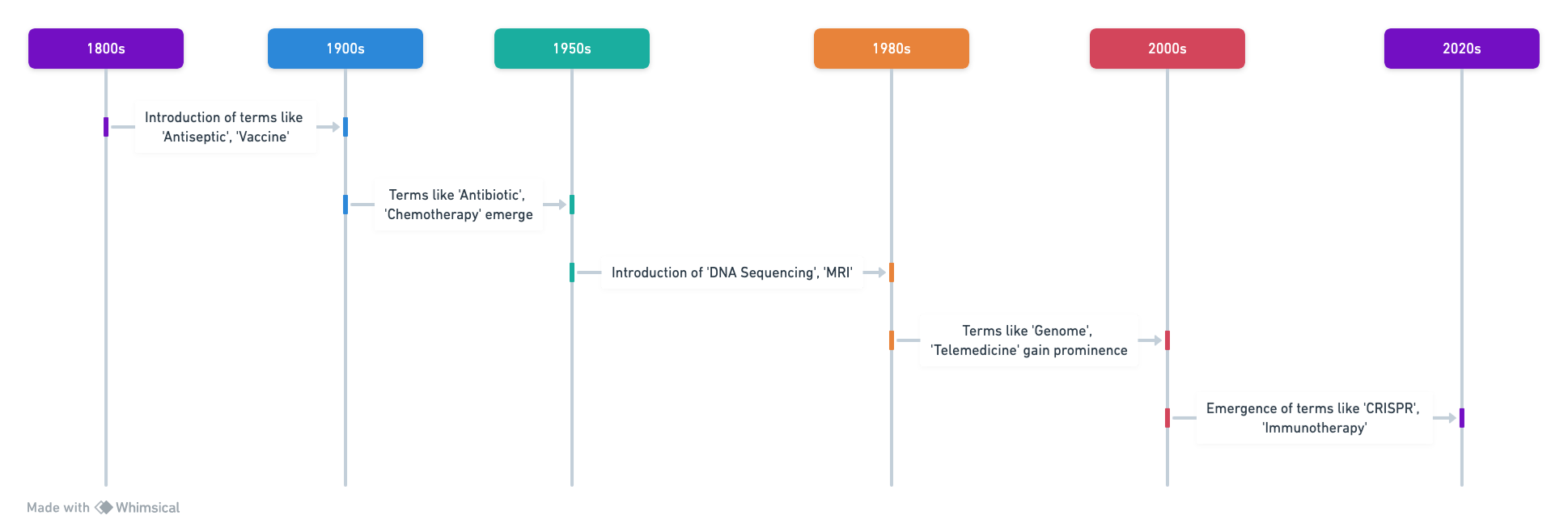
Resources for Further Learning
Expanding your understanding of medical terminology is facilitated by a variety of resources, each offering unique perspectives and methods of learning. From traditional textbooks to digital platforms, these resources cater to diverse learning styles and needs.
Table: Specific Resources for Medical Terminology
|
Resource Type |
Specific Resource |
Description |
Useful For |
|---|---|---|---|
|
Textbooks |
“Medical Terminology for Dummies” |
Simplified explanations of medical terms |
Beginners |
|
Online Courses |
Coursera’s Medical Terminology Course |
Comprehensive online learning modules |
In-depth study |
|
Mobile Apps |
MedTerm Scramble |
Interactive app for learning on the go |
Practice and revision |
|
Journals |
The New England Journal of Medicine |
Regular updates on medical advancements |
Keeping up-to-date with new terms |
|
Websites |
WebMD Medical Dictionary |
Online dictionary with extensive term listings |
Quick reference and clarification |
Guide 2: Tips on Using These Resources
- Combine traditional and digital resources for a balanced approach.
- Utilize interactive tools for active learning.
- Regularly consult medical journals for the latest in medical terminology and advancements.
Conclusion
We have journeyed through the intricate landscape of medical terminology, exploring its fundamental structures, specialty-specific terms, and common pitfalls. This guide aims to provide a foundational understanding, crucial for anyone in the healthcare field or aspiring to enter it. The importance of mastering this language cannot be overstated, as it is essential for accurate diagnosis, treatment, and communication within the medical community.
As you move forward, remember that the journey of learning medical terminology is ongoing. Embrace the challenges and complexities of this language with enthusiasm. Regular practice, continuous learning, and application in real-world scenarios will deepen your understanding and enhance your communication skills in the medical field. Your dedication to this endeavor will not only benefit your professional growth but also contribute significantly to the quality of patient care and medical research.
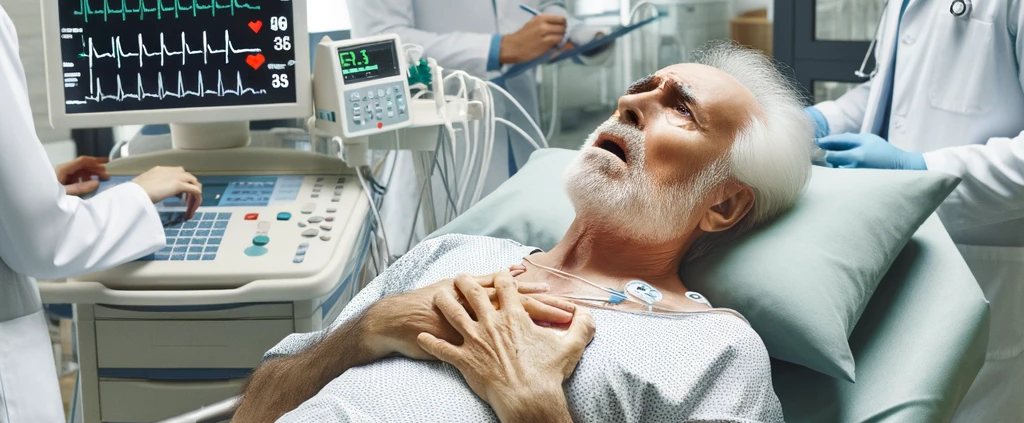


Great resource! Easy to read. Very factual. Great tool for medical students to get a quick understanding of how medical terms are derived.
So many have disappeared or are on the verge of disappearing resulting from lack of support and current modifications in law.